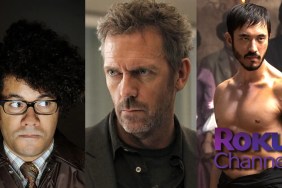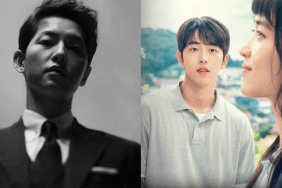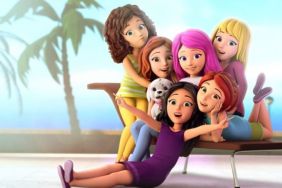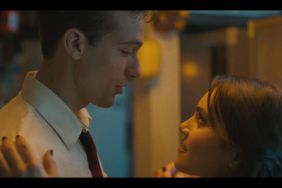
Andy and Barbara collaborated on the short film upon which Mama is based off of (watch it at the bottom of this interview). And, in our discussion, we talk about the challenges of expanding the short film’s concept, the feature film’s inspirations and eponymous supernatural entity that haunts Jessica Chastain’s character, Annabel.
Mama opens in theaters January 18, 2013.
Question: While you were doing the short film, did you know the story you wanted to tell with the feature? Did you have it pre-planned out in your head?
Andy Muschietti: Actually, it was a different story. We were writing a different screenplay, and Mama the short was sort of a style exercise to support the project. It was a ghost story, also a horror supernatural thriller, but the story was not Mama. But the short film, it wasn’t even a short. We did [Mama] as a support piece and we put the credits on it and sent it to festivals. We started to raise interest, and a lot of people were asking what was the story behind it. It’s a big question mark. People usually asked how was it possible that those little girls are that thing’s daughters. So, that motivated us for writing the story. Usually they were more interested in seeing what happened to the girls…
Barbara Muschietti: Than in reading our screenplay.
Andy: Which wasn’t bad at all.
Barbara: It’s good, it’s good! We’ll shoot it someday.
Andy: We stole so much from our previous screenplay that we’re not using it anymore.
Question: How long have you two been working creatively together?
Barbara: [We’ve] been working together for 10 years, and writing together for about 8. But we’ve always been siblings.
Andy: We lived for 10 years in different countries – she started in L.A. and I was in Buenos Aires. I moved to Spain while she was in London, and then [we were] together in Barcelona where we started a company. And it was like that for 10 years.
Question: At what point did you feel ready to go from directing commercials to a movie?
Andy: I’m not ready yet. [laughs] I guess it’s something that just happens, and you’re asking yourself. I guess I was more ready to make a film 10 years ago when I thought it was easier. And now that I’m doing it, I’m encountering all the little surprises and obstacles along the run. But I guess you never know when you are ready.
Question: Guillermo told us that he has a production meeting with you every morning and every afternoon. Can you tell us a little about those meetings and your relationship with him on this film?
Andy: It’s great because Guillermo is a big reference. And the good thing about him is he’s very demanding. When he feels okay about something, he doesn’t have any problem to say “this is wrong,” or “I would have gone another way.” He’s very honest with that. He’s very generous when it comes to advice. He learns a lot from his proteges to say something. It’s a kind of a feedback. It’s great to have him every day and have his feedback. And sometimes – along the way – you can get lost with the confusion of what you’re doing. It’s a good thing having a response from a guy like him.
RELATED: Guillermo del Toro and Jessica Chastain On the Mysteries of Mama
Question: You mentioned that people were interested in what happened to the kids and that you cannibalized another script, but how difficult was it to break this story? Because that original short is such a mood piece and such a great story, how hard was it to find the story that you wanted to go with?
Andy: It happened in one day. It wasn’t difficult. The outline of the story just happens. It was like a spark, you find the idea and say “Ah.”
Barbara: We were in Madrid.
Andy: Yeah. Of course, it became harder and harder when you start developing and seeing all the problems of that story out there. In the short film, it has this impact because it’s so short. It’s not surrounded by anything. There is a big deal of intrigue. In the movie you need to explain a lot of things in order to tell a story with characters and drama. One of the goals is to maintain the impact of the short. Because that scene is in the movie. The idea is to make that scene as impactful as it is in the movie, and, of course, change it for all the people who saw the short film. When [those people see] the movie it would be disappointing to see the same scene. So, there are a couple of twists in this version.

Question: You mentioned Juan Carlos. There is a movement of filmmakers coming out of Colombia, Argentina, Spain. Who else are you guys friends with? Do you have a little creative circle that you turn to for advice?
Andy: Well I studied in Buenos Aires in Argentina, so my film friends belong to that circle. I don’t know if you know Pablo Fendrik, he’s an Argentinean filmmaker, he’s my age and we’re very close friends. Then there’s alot of people who are friends, not as close as Pablo. There’s Pablo Trapero, we studied in the same school at the same time. There’s also Lucrecia Martel – these guys, it’s different because they are different talents, they belong to a different genre. Argentina is a bit tough to people. You don’t embrace genre film in general. They are more like, in the film community, a bit snobby. We think that we have to make really compromised social statements. It makes sense because South America, and countries like Argentina, have gone through a lot of shit, and filmmakers think that they have to come in with important messages. But there’s nothing wrong about genre.
Question: I’m curious about the character of Annabel. She seems like she wouldn’t be the star of a movie like this – the punk rocker usually dies. Where did this character come from?
Andy: That was a chemistry needed, I guess. For horror, the needs of the story have to be first. And this is a woman who – by accident – from one day to the next she has to take the responsibility of raising two little children who aren’t hers. It’s a reluctant hero, and you will notice when you see the movie she’s not the hero at all. But there’s kind of a twist that makes her jump in the driver’s seat, just like that, and she’s the least apt person for the job. That’s where it comes from I guess.
Question: Do you have specific artistic references for the film? Your producer was talking about Modigliani paintings that you had that kind of inspired you. What other paintings or films inspired Mama?
Babara: I think Modigliani, we had a Modigliani growing up, and it scared the shit out of us. When he started drawing Mama, it was very – Andy draws – it was very clear that there was a big, elongated Modigliani air to Mama. It’s very scary visuals.
Andy: Yes, especially for the character. There’s tons of influences that come together here. I’m a big fan of Edward Gorey, and I don’t think he has been portrayed in film. Well, Tim BUrton is a fan too. But the horrific part of Edward Gorey, how he frames things is very disturbing. And I think that Mama will have a lot of that.

Barbara: The Modigliani? I don’t know the name.
Andy: But his portraits are all women with no eyes, the eyes are empty, they have a tendency of stretching the faces and the necks. I don’t know if it’s scary for everyone, but for a lot of people, it’s very scary.
Barbara: There’s also a lady that dies in the water, and I think something that had quite a bit of impact when we were younger was this painting of Ophelia in the water, floating.
Question: Do you see the character of Mama as a monster or someone we can be empathetic toward?
Andy: It’s a mix. It’s funny, because it’s a character you don’t emphasize with, because you’re not on the right perspective. But if you could understand what’s going on, it’s the story of a mom trying to get her children back. I think we played with that. It’s the displacement of the bad positioning of the point of view, which makes you empathize with the human characters. If you asked the girls, actually…
Barbara: They love her. She’s a horrible hero, really. That’s what she is.
Andy: One of the elements of horror is that we are building a big question of what is the character. It’s there, it’s horrifying. But you learn a lot of things, you see that the girls love this thing. You’re not sure if it’s real or not, but they follow her, they mimic her, you see a lot of traits from the mysterious character that is reflected on the girls. And when you see it, it doesn’t matter all you know about their love, because it’s so horrifying that you shit yourself. Ideally. So, that’s the game we’re playing.
Question: Did you look at a couple of different actresses or actors before settling on Javier for Mama?
Andy: No. Well, we went through a phase where I was sure that she wouldn’t be human, that there would be CG, because I wanted to do very strange motion, and the proportions of the character couldn’t be portrayed by any human. Then I saw Javier in REC. I don’t know if you guys saw REC, but at the end of REC, I thought he was a CG character, because the proportions were not real. You see this thing swaying around But even then, I think I still thought of doing CG. But then, I don’t know, I realized that it just wouldn’t be as good as the CG is, there’s always something that tells you it’s CG.
Barbara: And also when you give something so important as this character, Mama, to a company to do, even if it’s with your supervision, even if you’re on it, it becomes a very different thing, and you lose the ability to really mold it during your shoot. But that’s why we did the test that we showed you, and that’s why we did other tests prior to that.

Question: Does Mama talk?
Andy: I can’t tell you. It’s going to be like Rise of the Planet of the Apes. [laughs] I don’t know if she does, but she does sing. It’s one of those reflections on the girls. You see the girls singing and it’s something they learned from Mama. There is sort of a leitmotif, which is a handprint on the girls – how much we can attach to anything that is there. There is sort of a fracture there, because when the girls were abandoned, one was three and a half years old and the other was a baby. When they go back to normal, one of them is recovered by society, and the other has been raised by Mama. So, there is a fracture there.
Stay up to date with the latest horror news by “liking” Shock Till You Drop’s Facebook page and following us on Twitter!









